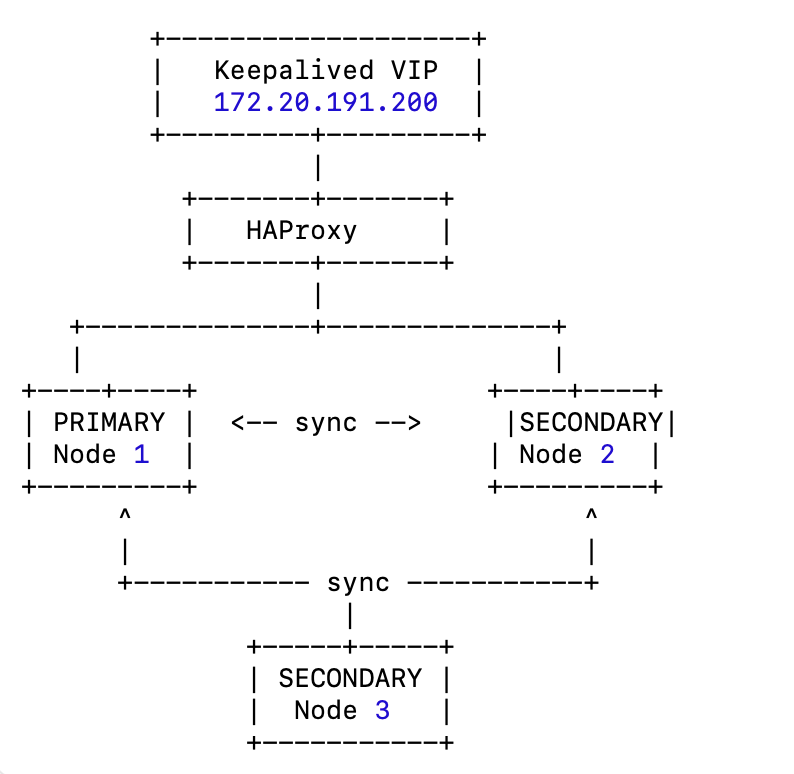Docker Compose 部署高可用 MongoDB 副本集集群(含 Keepalived + HAProxy 负载均衡)
-
- 背景与目标
- [📋 环境规划](#📋 环境规划)
- 部署步骤
-
- [1. 创建目录结构](#1. 创建目录结构)
- [2、生成 keyFile(三台机器内容必须一致)](#2、生成 keyFile(三台机器内容必须一致))
- [3. 准备 Keepalived + HAProxy 配置](#3. 准备 Keepalived + HAProxy 配置)
- [4、部署 MongoDB 副本集](#4、部署 MongoDB 副本集)
- [5. 初始化副本集](#5. 初始化副本集)
- [6. 创建管理员账户](#6. 创建管理员账户)
- [7. 配置 Prometheus 监控](#7. 配置 Prometheus 监控)
- 8、验证集群状态
背景与目标
在生产环境中,单节点的 MongoDB 一旦宕机会导致服务中断。为了保证 高可用 和 数据一致性 ,我们使用 MongoDB 副本集(Replica Set) 配合 Keepalived + HAProxy 构建一个高可用架构,支持自动故障转移,并在应用端通过虚拟 IP(VIP)实现透明访问。
本文将介绍如何在三台服务器上使用 Docker Compose 部署 MongoDB 7.0 副本集,并通过 Keepalived + HAProxy 提供高可用访问入口,同时配置 Prometheus 监控指标采集。
📋 环境规划

服务器信息
| 节点 | 主机名 | IP地址 | 角色 |
|---|---|---|---|
| 1 | domp-server-001 | 172.20.191.185 | PRIMARY 节点 |
| 2 | domp-server-002 | 172.20.191.186 | SECONDARY 节点 |
| 3 | domp-server-003 | 172.20.191.187 | SECONDARY 节点 |
软件版本
- MongoDB:
7.0 - Docker:
>= 20.10 - Docker Compose:
>= 1.29 - Keepalived & HAProxy: 自定义镜像(基于生产优化)
部署步骤
1. 创建目录结构
bash
mkdir -p /data/mongodb/{data,logs,key}2、生成 keyFile(三台机器内容必须一致)
MongoDB 副本集认证需要一个共享的 keyFile,用于节点间安全通信。
bash
openssl rand -base64 756 > /data/mongodb/key/mongodb-keyfile
chmod 400 /data/mongodb/key/mongodb-keyfile
chown 999:999 /data/mongodb/key/mongodb-keyfile• 999:999 是 MongoDB 容器内的默认用户 UID/GID。
• 将 /data/mongodb/key/mongodb-keyfile 拷贝到所有三台机器相同路径下。3. 准备 Keepalived + HAProxy 配置
docker-compose-keepalived-haproxy.yml 内容
yml
version: "3.9"
services:
keepalived:
image: reg.deeplearning.cn/mmwei3/keepalived:latest-20250725
container_name: keepalived
restart: always
network_mode: host
privileged: true
tty: true
environment:
- KOLLA_CONFIG_STRATEGY=COPY_ALWAYS
- KOLLA_SERVICE_NAME=keepalived
volumes:
- /etc/kolla/keepalived/:/var/lib/kolla/config_files/:ro
- /etc/localtime:/etc/localtime:ro
- /lib/modules:/lib/modules:ro
- haproxy_socket:/var/lib/kolla/haproxy/
haproxy:
image: reg.deeplearning.cn/mmwei3/haproxy:latest-20250725
container_name: haproxy
restart: always
network_mode: host
privileged: true
tty: true
environment:
- KOLLA_CONFIG_STRATEGY=COPY_ALWAYS
- KOLLA_SERVICE_NAME=haproxy
volumes:
- /etc/kolla/haproxy/:/var/lib/kolla/config_files/:ro
- /etc/localtime:/etc/localtime:ro
- haproxy_socket:/var/lib/kolla/haproxy/
volumes:
haproxy_socket:说明
• Keepalived 用于提供 VIP(虚拟 IP)漂移,保证故障切换。
• HAProxy 负责将请求路由到 MongoDB 副本集的 PRIMARY 节点。
4、部署 MongoDB 副本集
yaml
docker-compose-mongo.yml(示例为 domp-server-001):
version: '3.8'
services:
mongo:
image: reg.deeplearning.cn/mmwei3/mongo:7.0
container_name: mongo
restart: always
hostname: domp-server-001
ports:
- 27017:27017
volumes:
- /data/mongodb/data:/data/db
- /data/mongodb/logs:/var/log/mongodb
- /data/mongodb/key/mongodb-keyfile:/etc/mongo-keyfile:ro
command: >
mongod --replSet rs0
--auth
--keyFile /etc/mongo-keyfile
--bind_ip_all
--logpath /var/log/mongodb/mongod.log
--logappend
networks:
- mongo_net
networks:
mongo_net:
driver: bridge另外两台机器只需修改 hostname 与数据路径即可。
5. 初始化副本集
bash
docker exec -it mongo mongoshMongo shell 中执行:
js
rs.initiate({
_id: "rs0",
members: [
{ _id: 0, host: "172.20.191.185:27017" },
{ _id: 1, host: "172.20.191.186:27017" },
{ _id: 2, host: "172.20.191.187:27017" }
]
})6. 创建管理员账户
js
use admin
db.createUser({
user: "admin",
pwd: "<your_password_here>",
roles: [ { role: "root", db: "admin" } ]
})
mongosh -u admin -p <your_password_here> --authenticationDatabase admin7. 配置 Prometheus 监控
启动 mongodb-exporter 容器:
python
docker run -d \
--name mongodb_exporter \
-p 9216:9216 \
-e MONGODB_URI="mongodb://admin:<your_password_here>@172.20.191.185:27017/?replicaSet=rs0" \
reg.deeplearning.cn/mmwei3/bitnami/mongodb-exporter:latest-20250718_x86 \
--no-mongodb.direct-connect \
--collector.dbstats \
--collector.topmetrics \
--collector.indexstats \
--collector.collstats \
--collector.replicasetstatus8、验证集群状态
python
root@domp-server-001:/# mongosh -u admin -p <your_password_here> --authenticationDatabase admin
Current Mongosh Log ID: 688b0eb4c0d8fffe6989b03c
Connecting to: mongodb://<credentials>@127.0.0.1:27017/?directConnection=true&serverSelectionTimeoutMS=2000&authSource=admin&appName=mongosh+2.5.6
Using MongoDB: 7.0.22
Using Mongosh: 2.5.6
For mongosh info see: https://www.mongodb.com/docs/mongodb-shell/
------
The server generated these startup warnings when booting
2025-07-31T06:29:54.168+00:00: You are running on a NUMA machine. We suggest launching mongod like this to avoid performance problems: numactl --interleave=all mongod [other options]
2025-07-31T06:29:54.169+00:00: vm.max_map_count is too low
------
rs0 [direct: primary] test>
rs0 [direct: primary] test> rs.status()
{
set: 'rs0',
date: ISODate('2025-07-31T06:35:54.773Z'),
myState: 1,
term: Long('1'),
syncSourceHost: '',
syncSourceId: -1,
heartbeatIntervalMillis: Long('2000'),
majorityVoteCount: 2,
writeMajorityCount: 2,
votingMembersCount: 3,
writableVotingMembersCount: 3,
optimes: {
lastCommittedOpTime: { ts: Timestamp({ t: 1753943744, i: 1 }), t: Long('1') },
lastCommittedWallTime: ISODate('2025-07-31T06:35:44.926Z'),
readConcernMajorityOpTime: { ts: Timestamp({ t: 1753943744, i: 1 }), t: Long('1') },
appliedOpTime: { ts: Timestamp({ t: 1753943744, i: 1 }), t: Long('1') },
durableOpTime: { ts: Timestamp({ t: 1753943744, i: 1 }), t: Long('1') },
lastAppliedWallTime: ISODate('2025-07-31T06:35:44.926Z'),
lastDurableWallTime: ISODate('2025-07-31T06:35:44.926Z')
},
lastStableRecoveryTimestamp: Timestamp({ t: 1753943704, i: 1 }),
electionCandidateMetrics: {
lastElectionReason: 'electionTimeout',
lastElectionDate: ISODate('2025-07-31T06:33:24.905Z'),
electionTerm: Long('1'),
lastCommittedOpTimeAtElection: { ts: Timestamp({ t: 1753943594, i: 1 }), t: Long('-1') },
lastSeenOpTimeAtElection: { ts: Timestamp({ t: 1753943594, i: 1 }), t: Long('-1') },
numVotesNeeded: 2,
priorityAtElection: 1,
electionTimeoutMillis: Long('10000'),
numCatchUpOps: Long('0'),
newTermStartDate: ISODate('2025-07-31T06:33:24.919Z'),
wMajorityWriteAvailabilityDate: ISODate('2025-07-31T06:33:25.423Z')
},
members: [
{
_id: 0,
name: '172.20.191.185:27017',
health: 1,
state: 1,
stateStr: 'PRIMARY',
uptime: 361,
optime: { ts: Timestamp({ t: 1753943744, i: 1 }), t: Long('1') },
optimeDate: ISODate('2025-07-31T06:35:44.000Z'),
lastAppliedWallTime: ISODate('2025-07-31T06:35:44.926Z'),
lastDurableWallTime: ISODate('2025-07-31T06:35:44.926Z'),
syncSourceHost: '',
syncSourceId: -1,
infoMessage: '',
electionTime: Timestamp({ t: 1753943604, i: 1 }),
electionDate: ISODate('2025-07-31T06:33:24.000Z'),
configVersion: 1,
configTerm: 1,
self: true,
lastHeartbeatMessage: ''
},
{
_id: 1,
name: '172.20.191.186:27017',
health: 1,
state: 2,
stateStr: 'SECONDARY',
uptime: 160,
optime: { ts: Timestamp({ t: 1753943744, i: 1 }), t: Long('1') },
optimeDurable: { ts: Timestamp({ t: 1753943744, i: 1 }), t: Long('1') },
optimeDate: ISODate('2025-07-31T06:35:44.000Z'),
optimeDurableDate: ISODate('2025-07-31T06:35:44.000Z'),
lastAppliedWallTime: ISODate('2025-07-31T06:35:44.926Z'),
lastDurableWallTime: ISODate('2025-07-31T06:35:44.926Z'),
lastHeartbeat: ISODate('2025-07-31T06:35:52.910Z'),
lastHeartbeatRecv: ISODate('2025-07-31T06:35:53.911Z'),
pingMs: Long('0'),
lastHeartbeatMessage: '',
syncSourceHost: '172.20.191.185:27017',
syncSourceId: 0,
infoMessage: '',
configVersion: 1,
configTerm: 1
},
{
_id: 2,
name: '172.20.191.187:27017',
health: 1,
state: 2,
stateStr: 'SECONDARY',
uptime: 160,
optime: { ts: Timestamp({ t: 1753943744, i: 1 }), t: Long('1') },
optimeDurable: { ts: Timestamp({ t: 1753943744, i: 1 }), t: Long('1') },
optimeDate: ISODate('2025-07-31T06:35:44.000Z'),
optimeDurableDate: ISODate('2025-07-31T06:35:44.000Z'),
lastAppliedWallTime: ISODate('2025-07-31T06:35:44.926Z'),
lastDurableWallTime: ISODate('2025-07-31T06:35:44.926Z'),
lastHeartbeat: ISODate('2025-07-31T06:35:52.910Z'),
lastHeartbeatRecv: ISODate('2025-07-31T06:35:53.910Z'),
pingMs: Long('0'),
lastHeartbeatMessage: '',
syncSourceHost: '172.20.191.185:27017',
syncSourceId: 0,
infoMessage: '',
configVersion: 1,
configTerm: 1
}
],
ok: 1,
'$clusterTime': {
clusterTime: Timestamp({ t: 1753943744, i: 1 }),
signature: {
hash: Binary.createFromBase64('egpXegnGy7N0DNK8cxpAjSX2y7o=', 0),
keyId: Long('7533130418208374789')
}
},
operationTime: Timestamp({ t: 1753943744, i: 1 })
}
rs0 [direct: primary] test>
db.isMaster()
# 返回当前节点是 PRIMARY 还是 SECONDARY。
#手动切换 PRIMARY
rs.stepDown()
#当前 PRIMARY 会主动下台,触发选举新 PRIMARY。
# 添加新节点到副本集
rs.add("new_host:27017")
# 将新节点加入副本集。
# 从副本集中移除节点
rs.remove("host_to_remove:27017")
# 查看当前配置
rs.conf()
# 检查复制延迟
rs.printSlaveReplicationInfo()
# 显示 SECONDARY 节点复制延迟信息。
# 备份数据(使用 mongodump)
mongodump --host <primary_host> --port 27017 -u admin -p <password> --authenticationDatabase admin --out /backup/path/
# 恢复数据(使用 mongorestore)
mongorestore --host <host> --port 27017 -u admin -p <password> --authenticationDatabase admin /backup/path/